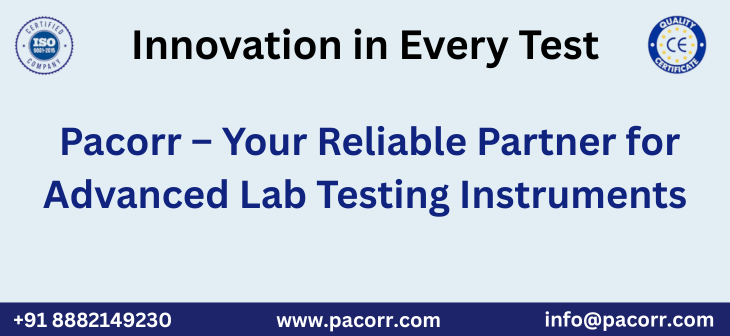
Introduction: Pacorr and the Importance of Vibration Table Testing Standards
Pacorr is a leading name in the manufacturing and supply of advanced testing instruments, catering to diverse industries with a special focus on quality, reliability, and compliance with global standards. Among Pacorr’s wide portfolio of laboratory testing solutions, the Vibration Table stands out as a critical tool for simulating the transport and handling stresses that packaged products encounter during their lifecycle. For businesses that prioritize product integrity and supply chain excellence, understanding which standard is used for Vibration Table testing is fundamental. This article explores the major standards associated with vibration testing, explains their relevance, and details how Pacorr’s Vibration Table aligns with these benchmarks to ensure accurate and trustworthy results.
What is a Vibration Table?
A Vibration Table, also known as a vibration testing table or vibrating table, is a precision-engineered device designed to subject products or packaging materials to controlled vibration environments. The main goal is to replicate the dynamic conditions experienced during shipping, transportation, and storage. Pacorr’s Vibration Table is widely used across industries such as packaging, automotive, electronics, pharmaceuticals, and consumer goods. The ability to simulate real-world vibrational forces is crucial for assessing the structural integrity, durability, and packaging efficiency of products, ultimately ensuring that they reach the end customer in optimal condition.
Why are Vibration Testing Standards Necessary?
Adherence to recognized standards in vibration testing is not only a mark of quality assurance but also a requirement for regulatory compliance and global trade. Testing standards help ensure that results are consistent, repeatable, and comparable across different laboratories and geographies. For manufacturers, exporters, and logistics companies, compliance with vibration testing standards translates to fewer product returns, reduced damages, and improved customer satisfaction. Pacorr emphasizes the importance of following these standards to support businesses in meeting international quality expectations.
Major Standards Used for Vibration Table Testing
The field of vibration testing is governed by a set of international standards developed by recognized organizations such as ASTM International, the International Organization for Standardization (ISO), and the International Safe Transit Association (ISTA). Below are some of the most influential standards relevant to Vibration Table testing:
1. ASTM D999 – Standard Test Methods for Vibration Testing of Shipping Containers
ASTM D999 is one of the most widely adopted standards for vibration testing using a vibration table. This standard specifies procedures for subjecting filled shipping containers to repetitive vertical motions simulating the vibration experienced during transport. The primary objectives of ASTM D999 include evaluating the ability of packaging to protect its contents and assessing the suitability of containers for transportation.
Key Highlights:
- Focuses on vertical vibration using a mechanical or electrodynamic vibration table
- Offers two procedures: Procedure A (Repetitive Shock) and Procedure B (Sine Vibration)
- Ensures comparability and repeatability of test results
- Applied extensively in packaging, logistics, and shipping industries
2. ASTM D4728 – Random Vibration Testing of Shipping Containers
ASTM D4728 addresses random vibration testing for shipping containers and systems, replicating the complex and unpredictable vibration spectrum encountered during real-life transportation. Unlike repetitive or sinusoidal vibration, random vibration better simulates the actual environment experienced on trucks, railways, or cargo ships.
Key Highlights:
- Utilizes random vibration profiles to match transport conditions
- Allows for data-driven, realistic simulation
- Particularly valuable for high-value and sensitive products
3. ISTA Series (International Safe Transit Association)
The ISTA has developed a series of packaging test protocols that include vibration testing as a core component. The most prominent ones are ISTA 1A, ISTA 2A, ISTA 3A, and ISTA 6-Amazon.com, all of which prescribe vibration table testing procedures for packaged products.
Key Highlights:
- Widely recognized by shippers, eCommerce platforms, and logistics providers
- Designed to simulate a variety of distribution environments
- Mandated by global brands and marketplaces for packaging qualification
4. ISO 2247 – Packaging: Complete, Filled Transport Packages – Vibration Test Methods
ISO 2247 specifies vibration test methods for transport packages and is harmonized with several regional and national standards. The ISO 2247 procedure evaluates the resistance of complete, filled transport packages to vertical vibration, ensuring international consistency in testing practices.
Key Highlights:
- Specifies vibration testing conditions and apparatus
- Recognized globally, especially for international trade
- Helps harmonize packaging quality across borders
5. ISO 13355 – Packaging: Complete, Filled Transport Packages and Unit Loads – Vertical Random Vibration Test
ISO 13355 details procedures for subjecting packaged products and unit loads to vertical random vibration testing, closely mimicking the stressors encountered in multi-modal transportation systems.
Key Highlights:
- Focuses on vertical random vibration
- Suitable for both packages and unit loads (pallets)
- Essential for global logistics operations
Why Pacorr’s Vibration Table is Trusted for Standards Compliance
Pacorr’s Vibration Table is engineered to comply with all major vibration testing standards including ASTM D999, ASTM D4728, ISTA protocols, ISO 2247, and ISO 13355. The equipment is designed with precise control systems, robust construction, and user-friendly interfaces, allowing for both repetitive and random vibration testing as per regulatory requirements. The product’s adaptability and reliability make it the preferred choice for quality managers, R&D professionals, and packaging engineers seeking accurate and standardized results.
Selecting the Right Standard for Your Application
The choice of standard depends on the product type, mode of transportation, and customer or regulatory requirements. For instance, shipping containers destined for export may require compliance with ISO 2247 or ASTM D999, while sensitive electronics or pharmaceuticals might demand advanced random vibration testing per ASTM D4728 or ISTA 3A protocols. Pacorr provides expert consultation to help customers select the appropriate standard for their industry and application.
Vibration Table Testing Process as per Standards
The vibration testing process typically includes the following steps:
1.Sample Preparation: The product or package is prepared and conditioned as per the standard.
2.Mounting: The sample is securely mounted on the vibration table.
3.Test Selection: The required test procedure is selected (repetitive, random, or sinusoidal vibration).
4.Test Execution: The vibration table is operated according to the specified frequency, amplitude, and duration.
5.Monitoring: Data is collected on product or package performance during the test.
6.Evaluation: Results are evaluated to determine compliance with the relevant standard.
Pacorr’s Vibration Table comes equipped with advanced data acquisition systems, enabling comprehensive analysis and documentation to support compliance and traceability.
Benefits of Using Standardized Vibration Table Testing
- Quality Assurance: Reduces the risk of product damage during transit.
- Regulatory Compliance: Meets customer and statutory requirements for global trade.
- Customer Confidence: Demonstrates a commitment to quality and safety.
- Process Optimization: Identifies weaknesses in packaging or product design for continuous improvement.
- Cost Savings: Minimizes the incidence of returns and replacements.
Industries Benefiting from Vibration Table Testing
- Packaging and Logistics: To qualify shipping containers, cartons, and pallets.
- Automotive: For components and assemblies exposed to vibration during shipment and operation.
- Electronics: To verify the durability of devices and assemblies.
- Pharmaceuticals: For secure transport of sensitive medications and devices.
- Consumer Goods: To ensure product quality throughout the supply chain.
Pacorr’s Experience, Expertise, Authoritativeness, and Trustworthiness in Vibration Testing
Pacorr has established itself as a leader in laboratory testing equipment by consistently delivering products that adhere to global standards. The company’s expertise in vibration testing, combined with decades of experience and continuous R&D, ensures that customers receive not just equipment but also guidance on compliance and best practices. By investing in Pacorr’s Vibration Table, businesses demonstrate their commitment to quality, compliance, and customer satisfaction.
Conclusion: Elevate Your Quality Assurance with Pacorr’s Vibration Table
Understanding which standard is used for Vibration Table testing is the first step towards building a robust quality assurance program. By aligning with ASTM, ISTA, and ISO standards, companies can enhance product reliability, reduce costs, and strengthen their reputation in the marketplace. Pacorr’s Vibration Table, with its versatile features and compliance with leading standards, is the ideal choice for any business aiming for excellence in packaging and product testing.
Frequently Asked Questions (FAQ) About Vibration Table Testing Standards
Q1. Which standard is most commonly used for Vibration Table testing?
ASTM D999 and ISO 2247 are widely recognized for repetitive vibration testing of shipping containers and transport packages.
Q2. Can Pacorr’s Vibration Table perform random vibration testing?
Yes, Pacorr’s Vibration Table supports random vibration testing in compliance with ASTM D4728 and ISO 13355.
Q3. Why is vibration testing important in packaging?
Vibration testing helps ensure that packaging can protect products during transportation, reducing the risk of damage and customer returns.
Q4. What industries benefit from Vibration Table testing?
Industries such as packaging, automotive, electronics, pharmaceuticals, and consumer goods rely on vibration testing for quality assurance.
Q5. How do I choose the right vibration testing standard?
The appropriate standard depends on product type, shipping method, and customer or regulatory requirements. Pacorr can provide expert guidance for your specific needs.
Thanks to Pacorr Testing instruments, we have all the required quality testing instruments that have helped us to ensure the best quality delivered to our clients.

Danish
Fair Exports Pvt. Ltd.

